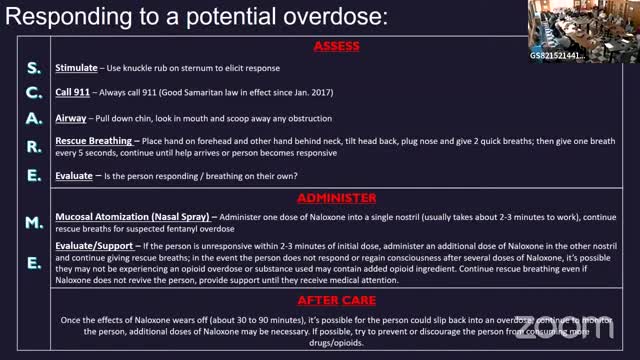How to save a life during an overdose emergency
August 09, 2024 | Berrien County, Michigan
This article was created by AI summarizing key points discussed. AI makes mistakes, so for full details and context, please refer to the video of the full meeting. Please report any errors so we can fix them. Report an error »

In a recent community health meeting, officials discussed critical life-saving techniques for responding to suspected drug overdoses, emphasizing the importance of immediate action and the use of Narcan, a medication designed to reverse opioid overdoses.
Participants were instructed on the initial steps to take when encountering someone who may have overdosed. A sternum rub was highlighted as a method to assess consciousness; if the individual responds, they are likely not experiencing an overdose. However, if there is no response, calling 911 is imperative. The meeting underscored the protections offered by Good Samaritan laws, which shield individuals from legal repercussions when they seek help for someone experiencing an overdose.
The discussion included detailed instructions on administering rescue breathing and using Narcan. Attendees learned to check the person's airway and ensure they are positioned safely to prevent choking. The proper technique for rescue breathing was outlined, including maintaining a clear airway and providing breaths every five seconds. If the individual remains unresponsive, Narcan should be administered every two to three minutes, with careful attention to the medication's application.
The meeting also addressed the emotional aftermath of an overdose reversal. Participants were encouraged to provide support to individuals waking from an overdose, as they may experience withdrawal symptoms and a strong urge to use drugs again. The importance of compassion and understanding was emphasized, as recovery is a complex journey that may require multiple attempts.
Overall, the meeting served as a vital reminder of the community's role in addressing the ongoing opioid crisis, equipping attendees with the knowledge and skills necessary to potentially save lives.
Participants were instructed on the initial steps to take when encountering someone who may have overdosed. A sternum rub was highlighted as a method to assess consciousness; if the individual responds, they are likely not experiencing an overdose. However, if there is no response, calling 911 is imperative. The meeting underscored the protections offered by Good Samaritan laws, which shield individuals from legal repercussions when they seek help for someone experiencing an overdose.
The discussion included detailed instructions on administering rescue breathing and using Narcan. Attendees learned to check the person's airway and ensure they are positioned safely to prevent choking. The proper technique for rescue breathing was outlined, including maintaining a clear airway and providing breaths every five seconds. If the individual remains unresponsive, Narcan should be administered every two to three minutes, with careful attention to the medication's application.
The meeting also addressed the emotional aftermath of an overdose reversal. Participants were encouraged to provide support to individuals waking from an overdose, as they may experience withdrawal symptoms and a strong urge to use drugs again. The importance of compassion and understanding was emphasized, as recovery is a complex journey that may require multiple attempts.
Overall, the meeting served as a vital reminder of the community's role in addressing the ongoing opioid crisis, equipping attendees with the knowledge and skills necessary to potentially save lives.
View full meeting
This article is based on a recent meeting—watch the full video and explore the complete transcript for deeper insights into the discussion.
View full meeting
